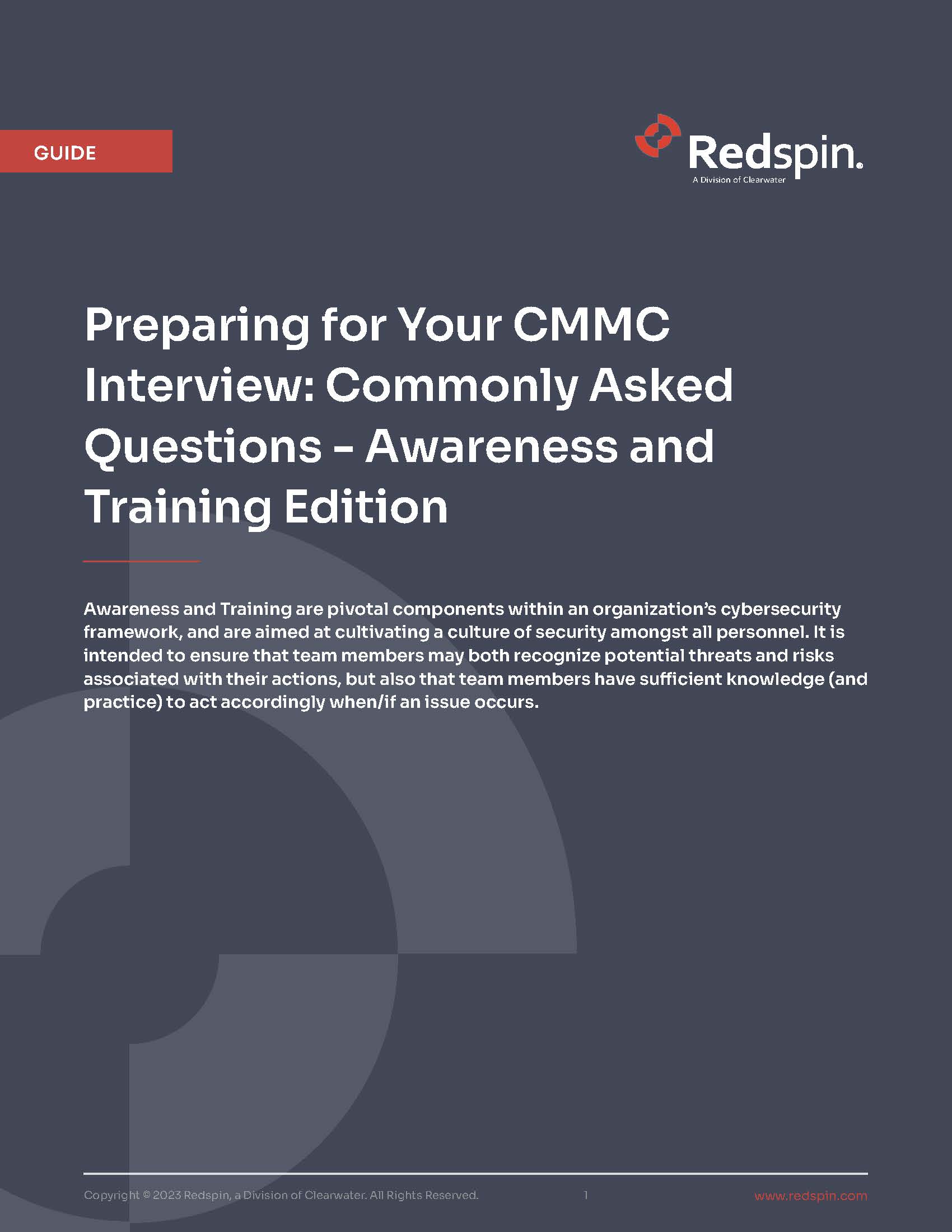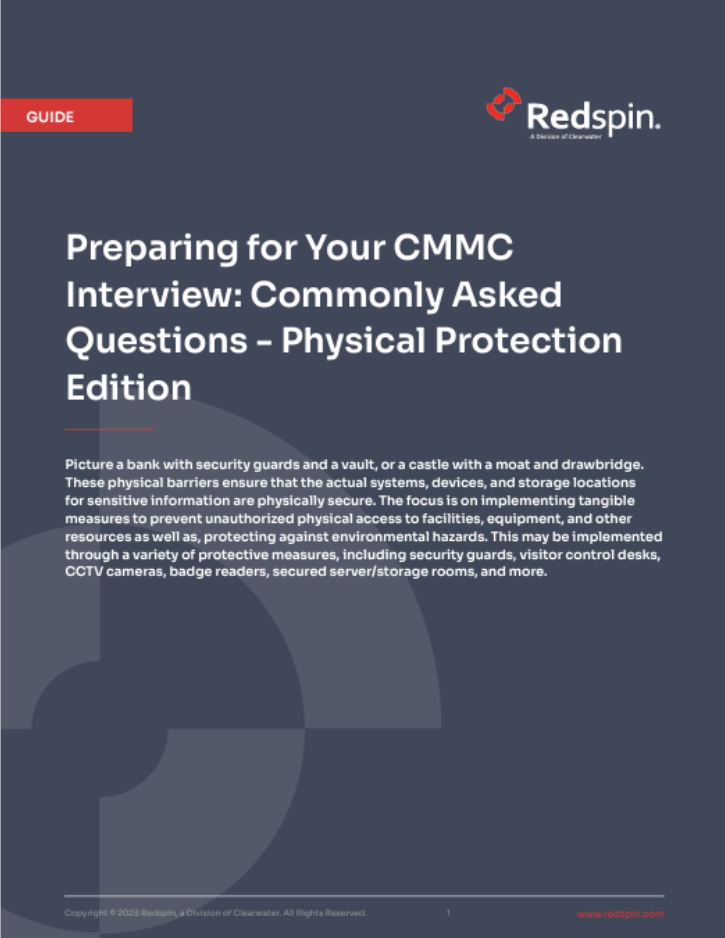CMMC Assessment Interview Questions
Question Guides for all 14 Domains

Put together by a C3PAO, these guides include the most common questions asked during a CMMC assessment interview. Complete the form below for full access to the comprehensive guide covering all 14 CMMC domains, with the option to download each individually.
Prepare your team, practice scenarios, and develop strategies to ensure success in every assessment aspect. Be able to access each guide as individual documents and hone in on questions specific to that domain.
Help your team responsible for each security control execution and ongoing management determine what to expect during an assessment.
Access Control
This is a fundamental element of CMMC practices in safeguarding CUI data protection and security. Deploying advanced and robust mechanisms effectively prevents unauthorized access to sensitive information and resources so only individuals or systems with proper authorization can execute specific actions. Questions also focus on how an organization provides ongoing access management.
Audit and Accountability
CMMC requires an organization to monitor system activities closely. This is to ensure individuals are held responsible and that there are detailed records that reveal discrepancies and facilitate thorough investigations. This approach fosters transparency and builds trust, enabling organizations to quickly address threats and vulnerabilities and maintain security best practices in protecting CUI data.
Awareness and Training
Security awareness and training are essential elements of an organization’s cybersecurity framework, fostering a strong security culture among all the staff. This domain ensures team members can identify potential threats and risks. The goal is to educate staff so they can proactively question if CUI data is at risk and possess the necessary knowledge and skills to respond effectively to address the threat.
Configuration Management
This domain focuses on establishing and maintaining consistency of a system’s performance and functional attributes. This requires strict control of changes made to hardware, software, and other components while maintaining all baselines and change documentation. Your business needs to guard against unauthorized changes that could introduce vulnerabilities and also be able to restore system operations quickly to the last known good configuration.
Identification & Authentication
Identification and Authentication are the digital equivalents of checking someone’s ID at the door. From a cybersecurity perspective, identification and authentication work collaboratively to ensure that users are who they say they are before granting access to a system or network. This domain looks at the implementation and ongoing management of an organization to ensure authorization before accessing CUI data.
Incident Response
Incident Response encompasses the strategies, processes, procedures, tools, resources, training, and other elements necessary to ensure an appropriate and meaningful response through detecting, managing, and mitigating security incidents. The primary focus is to respond in a manner that limits damage, reduces recovery time and costs, and ensures that the organization may resume normal operations as swiftly as possible.
Maintenance
This domain is essential for the health and maintenance of critical systems, akin to a routine health check-up or car service. It involves ongoing upkeep and updates of systems, hardware, and software to ensure peak performance. This regular maintenance helps identify and address minor issues early through periodic assessments and updates like patching vulnerabilities to protect against known and emerging threats.
Media Protection
Media Protection focuses on protecting digital and physical media, both in storage and transit. This includes USB drives, DVDs, hard drives, and even printed documentation that may include sensitive data. Media protection ensures that unauthorized entities cannot access, alter, or breach the data. These protections could include encryption, access control, physical locks, and secure transportation methods.
Personnel Security
This domain is vital, involving a thorough vetting process to ensure that all personnel with access to sensitive information are trustworthy. This process starts with a background check and includes ongoing monitoring of access and regular training. These actions help mitigate risks associated with human error, protecting sensitive data and fostering a culture of security awareness within the organization.
Physical Protection
We build physical protections similar to a bank or castle to keep sensitive information and CUI data safe. These protections help prevent unauthorized access to our facilities and equipment while guarding against environmental risks. We use various security measures such as security guards, visitor check-in areas, CCTV cameras, badge access systems, and secured server rooms to ensure everything remains protected.
Risk Assessment
Prepare and guard against potential threats and vulnerabilities by identifying and prioritizing their risk to CUI and the business. This involves systematically evaluating, and understanding potential threats and vulnerabilities that could adversely impact an organization’s assets and operations. Organizations may prioritize their resources and responses based on potential impact through this assessment.
Security Assessment
Regular checks of cybersecurity mechanisms help to ensure that security controls are effective and functioning as intended. This is achieved through ongoing assessments of information systems to identify vulnerabilities and compliance gaps, offering a view of the current security posture. Such insights help organizations mature, recognizing threats, weaknesses, and where they need to enhance controls.
System & Communications Protection
Safeguarding CUI data as it flows across networks and systems, ensuring that messages and/or data sent and received remain confidential and unaltered. Encryption, firewalls, intrusion detection systems (IDSs), secure protocols, and more are reviewed in their security from external threats and unauthorized access.
System Information & Integrity
This domain focuses on ensuring the accuracy, reliability, and overall integrity of CUI data and the systems it flows through – by ensuring the trustworthiness and proper functioning of the organization’s information systems. This includes detecting, preventing, and responding to potential compromises or corruptions in the data and system operations.
Keep focused and prepared for your upcoming CMMC Certification. Get the CMMC Assessment Guides today to help your organization.














